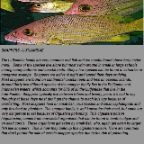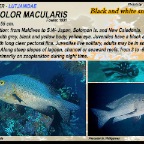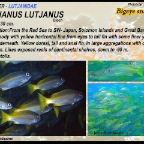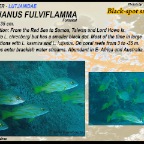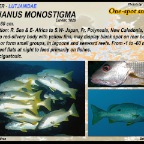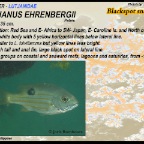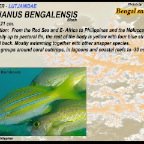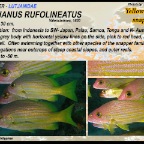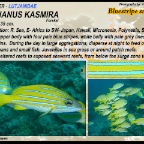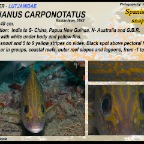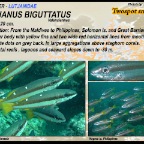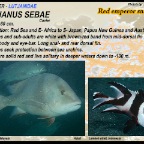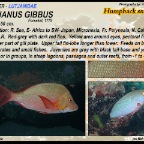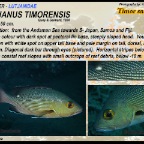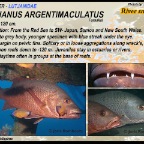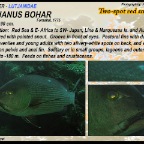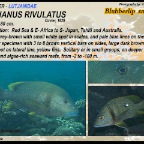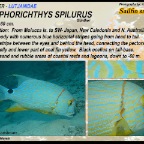Snappers - Lutjanidae
SNAPPERS - LUTJANIDAE
The Lutjanidae family are very common reef fish and are mostly found above forty meter mark. Some of the species live alone but most swim around in small or large schools among sandy bottoms and coastal reefs. Only a few species can be found in estuaries or mangrove swamps. Snappers are active at night and spend their days cruising. Most snappers are found on continental coastal reefs and less on oceanic islands. Around thirty two different species of the snapper family live in the Philippine and Indonesian waters, which accounts for 80% of all the Lutjanidae that live in the Indo-Pacific. Snappers typically live between fifteen and twenty years. It's sad to say though that these days most don't get the chance to reach this age because of overfishing. Most snappers feed on small fish, crustaceans and small cephalopods and only few feed on plankton. The snapper family is well known for their meat, but some are very dangerous to eat because of Ciguatera poisoning. This ciguatera poison (ciguatoxine) comes from one-celled organisms that can be found in benthic algae and on dead corals. These organisms get eaten by small fish, who, again get eaten by larger fish like snappers. This is how they build up this ciguatera poison. There are countries that don't permit the sale of certain snapper species due to the risk of poisoning. Length: 20 cm.Distribution: from the Maldives to Philippines, Solomon Is. and Great Barrier Reef.A slender body with yellow fins and two wide red horizontal lines from mouth to tail. Two white dots on grey back. In large aggregations above staghorn corals. On coastal reefs , lagoons and seaward slopes down to -30 m. Length: 60 cm.Distribution: from Molucca Is. to SW- Japan, New Caledonia and N. Australia.Yellow body with numerous blue horizontal stripes going from head to tail.Orange stripe between the eyes and behind the head, connecting the pectoral fins.Lower belly and lower part of anal fin yellow. Black ocellus on tail-base.Among sand and rubble areas of coastal reefs and lagoons, down to -60 m. Length: 120 cm.Distribution: from the Red Sea to SW- Japan, Samoa and New South Wales.Copper to grey body, younger specimen with blue streak under the eye. White margin on pelvic fins. Solitary or in loose aggregations along wreck’s, coastal- and lagoon reefs down to -120 m. Juveniles stay in estuaries or rivers. During daytime often in groups at the base of reefs. Length: 60 cm.Distribution: R. Sea & E- Africa to S.W- Japan, Fr. Polynesia, New Caledonia, Australia.Yellow to red-silvery body with yellow fins, may display black spot on rear back.Solitary or form small groups, in lagoons and seaward reefs. From -1 to -60 m. Enters reef flats at night to feed primarily on fishes. May be ciguatoxic. Length: 50 cm.Distribution: from the Andaman Sea towards S- Japan, Samoa and Fiji.Reddish colour with dark spot at pectoral fin base, steeply sloped head. Younger specimen with white spot on upper tail base and pale margin on tail, dorsal, anal and pelvic fin. Diagonal dark bar through eyes (pictured). Horizontal stripes below lateral line. On coastal reef slopes with small outcrops of reef debris, below -10 m.Length: 60 cm.Distribution: Red Sea and E- Africa to S- Japan, Papua New Guinea and Australia.Juveniles and sub-adults are white with brown-red band from mid-dorsal fin to tail, on mid-body and eye-bar. Long anal- and rear dorsal fin. Juveniles seek protection between sea urchins. Adults are solid red and live solitary in deeper waters down to -100 m. Length: 28 cm.Distribution: from Indonesia to SW- Japan, Palau, Samoa, Tonga and N- Australia.Pink-ish body colour with yellow lines on the side, pink to red head and yellow tail.Small dark area at base of pectoral fin. Often with other species.In aggregations near outcrops, steep coastal slopes and outer reefs. From -10 to -50 m. Length: 80 cm.Distribution: Red Sea & E- Africa to S- Japan, Tahiti and Australia.Adults grey-brown with small white spot in scales, and pale blue lines on the head.Younger specimen with 3 to 8 brown vertical bars on sides, large dark brown and white spot on lateral line, yellow fins. Solitary or in small groups, on deeper coastal slopes and algae-rich seaward reefs, from -2 to -100 m. Length: 35 cm.Distribution: R. Sea, E- Africa to SW- Japan, Hawaii, Micronesia, Polynesia, SE- Austr.Yellow upper body with four pale blue stripes, white belly with pale grey lines.Yellow fins. During the day in large aggregations, disperse at night to feed on benthic crustaceans and small fish. Juveniles in sea grass or around patch reefs. From sheltered reefs to exposed seaward reefs, from below the surge zone to -265 m. Length: 50 cm.Distribution: R. Sea, E- Africa to SW- Japan, Micronesia, Fr. Polynesia, N. Caledoniaand G.B.R. Red-grey with dark red fins. Yellow area around eyes, pectoral fin-baseand lower part of gill plate. Upper tail fin-lobe longer than lower. Feeds on benticinvertebrates and small fishes. Juveniles are grey with black tail-base and yellow tail. Solitary or in groups, in steep lagoons, passages and outer reefs, from -1 to -150 m. Length: 35 cm.Distribution: Red Sea and E- Africa to SW- Japan, E- Caroline Is. and North of G.B.R.Silvery-white body with 5 yellow horizontal lines below lateral line. Very similar to L. fulviflamma but yellow lines less bright. Yellowish tail and anal fin, large black spot on lateral line. Lives in groups on coastal and seaward reefs, lagoons and estuaries, from -1 to -20 m. Length: 21 cm.Distribution: from the Red Sea and E- Africa to Philippines and the Molucca’s.White belly up to pectoral fin, the rest of the body is yellow with four blue stripes onside and back. Mostly swimming together with other snapper species.In small groups around coral outcrops, in lagoons and coastal reefs to -30 m.Length: 55 cm.Distribution: from Maldives to S.W- Japan, Solomon Is. and New Caledonia.Adults with grey, black and yellow body, yellow eye. Juveniles have a black and whitebody with long clear pectoral fins. Juveniles live solitary, adults may be in small groups. Along steep slopes of lagoon, channel or seaward reefs, from 3 to -50 m.Feeds primarily on zooplankton during night time. Length: 35 cm.Distribution: from the Red Sea to Samoa, Taiwan and Lord Howe Is.Similar to L. ehrenbergi but has a smaller black dot. Most of the time in large aggregations with L. kasmira and L. lutjanus. On coral reefs from 3 to -35 m.Juveniles enter brackish water streams. Abundant in E- Africa and Australia. Length: 30 cm.Distribution: from the Red Sea to SW- Japan, Solomon Islands and Great Barrier Reef. Silvery body with yellow horizontal line from eyes to tail fin with some finer yellow lines underneath. Yellow dorsal, tail and anal fin. In large aggregations with other snappers. Likes exposed reefs of continental shelves, down to -90 m. Not on atolls.


